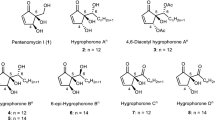Abstract
Three novel α-carbon derivatives of houttuyfonate—HOU-C8C1, HOU-C8C2, and HOU-C8C4—were designed and synthesized, and tested for their in vitro antibacterial activities against seven bacterial strains. A set of molecular properties of houttuyfonate and its five analogues were analyzed by MOPAC. Results indicated that the antibacterial activity of HOU-C8C1 is lower than that of HOU-C8. However, among HOU-C8C n (n = 1, 2, 4), as the hydrophobicity increased so did the activity, especially against Gram-positive bacteria. For the isomeric compounds HOU-C8C2 and HOU-C10, HOU-C8C4, and HOU-C12, the more negative the charges on carbon atom 2, the stronger the antibacterial activity exhibited. This suggests that the C(2) position is the antibacterial active center of houttuyfonate analogues, and that the weak antibacterial activities are possibly caused by the net negative charges on houttuyfonate homologues.




Similar content being viewed by others
References
Ahn HS, Cho W, Kang SH, Ko SS, Park MS, Cho H, Lee KH (2006) Design and synthesis of novel antimicrobial peptides on the basis of α helical domain of Tenecin 1, an insect defensin protein, and structure-activity relationship study. Peptides 27(4):640–648. doi:10.1016/j.peptides.2005.08.016
Azuma M, Kojimab T, Yokoyama I, Tajiri H, Yoshikawa K, Saga S, Del Carpio CA (2000) A synthetic peptide of human apoprotein E with antibacterial activity. Peptides 21(3):327–330. doi:10.1016/S0196-9781(00)00165-0
Burt S (2004) Essential oils: their antibacterial properties and potential applications in foods—a review. Int J Food Microbiol 94(3):223–253. doi:10.1016/j.ijfoodmicro.2004.03.022
Chen N, Yu QH, Wang DY, Feng Y (2002) Adjuvanticity of sodium houttuyfonate in vivo. Indian J Pharmacol 34(5):363–364
China PCO (ed) (2000) Pharmacopeia of People’s Republic of China. Chemical Industry Press, Beijing, pp 180–181
Dathe M, Schümann M, Wieprecht T, Winkler A, Beyermann M, Krause E, Matsuzaki K, Murase O, Bienert M (1996) Peptide helicity and membrane surface charge modulate the balance of electrostatic and hydrophobic interactions with lipid bilayers and biological membranes. Biochemistry 35(38):12612–12622. doi:10.1021/bi960835f
Holappa J, Hjálmarsdóttir M, Másson M, Rúnarsson Ö, Asplund T, Soininen P, Nevalainen T, Järvinen T (2006) Antimicrobial activity of chitosan N-betainates. Carbohydr Polym 65(1):114–118. doi:10.1016/j.carbpol.2005.11.041
Liang MM, Qi ML, Zhang CB, Zhou S, Fu RN, Huang JX (2005) Gas chromatography-mass spectrometry analysis of volatile compounds from Houttuynia cordata Thunb after extraction by solid-phase microextraction, flash evaporation and steam distillation. Anal Chim Acta 531(1):97–104. doi:10.1016/j.aca.2004.09.082
Matsuzaki K (1999) Why and how are peptide-lipid interactions utilized for self-defense? Magainins and tachyplesins as archetypes. BBA-Biomembranes 1462(1–2):1–10
Miao MS (ed) (1998) Pharmacology and clinical application of official traditional Chinese medicine. World Book, Beijing, pp 778–784
Pan Y, Shiell B, Wan J, Coventry MJ, Roginski H, Lee A, Michalski WP (2007) The molecular characterisation and antimicrobial activity of amidated bovine lactoferrin. Int Dairy J 17(6):606–616. doi:10.1016/j.idairyj.2006.08.005
Sara B (2004) Essential oils: their antibacterial properties and potential applications in foods—a review. Int J Food Microbiol 94(3):223–253
Shai Y (1999) Mechanism of the binding, insertion and destabilization of phospholipid bilayer membranes by α-helical antimicrobial and cell non-selective membrane-lytic peptides. BBA-Biomembranes 1462(1–2):55–70
Sitaram N, Nagaraj R (1999) Interaction of antimicrobial peptides with biological and model membranes: structural and charge requirements for activity. BBA-Biomembranes 1462(1–2):29–54
Wade D, Silberring J, Soliymani R, Heikkinen S, Kilpelainen I, Lankinen H, Kuusela P (2000) Antibacterial activities of temporin A analogs. FEBS Lett 479(1–2):6–9. doi:10.1016/S0014-5793(00)01754-3
Wang DY, Yu QH, Eikstadt P, Hammond D, Feng Y, Chen N (2002) Studies on adjuvanticity of sodium houttuyfonate and its mechanism. Int Immunopharmacol 2(10):1411–1418. doi:10.1016/S1567-5769(02)00060-7
Wayne P (ed) (2003) National Committee for Clinical Laboratory Standards, Methods for dilution antimicrobial susceptibility tests for bacteria that grow aerobically, document M7-A6
Ye XL, Li XG, Yuan LJ, He HM (2005) Effect of the surface activity on the antibacterial activity of octadecanoyl acetal sodium sulfite series. Colloid Surf A 268(1–3):85–89. doi:10.1016/j.colsurfa.2005.05.064
Ye XL, Li XG, Yuan LJ, He HM (2006a) Relationship between the antibacterial and immunological activities of houttuyfonate homologues and their surface activities. J Asian Nat Prod Res 8(4):327–334. doi:10.1080/10286020500035243
Ye XL, Li XG, Yuan LJ, Zhang BS (2006b) Interaction between houttuyfonate homologues and erythrocyte plasma membrane of rabbit in vitro. Colloid Surf A 279(1–3):218–224. doi:10.1016/j.colsurfa.2006.01.007
Ye XL, Li XG, Yuan LJ, Ge LH, Zhang BS, Zhou SB (2007) Interaction of houttuyfonate homologues with the cell membrane of gram-positive and gram-negative bacteria. Colloid Surf A 301(1–3):412–418. doi:10.1016/j.colsurfa.2007.01.012
Yuan LJ (2004) Relationship between the antibacterial and immunologic activity of houttuyfonate homologues and their surface activities. PhD thesis
Yuan LJ, Li XG, He HM (2005) Effects of sodium houttuyfonate analogues on lysozme activity both in vitro and in vivo. Chin J Trad Med 20:268–271
Yuan LJ, Wu JP, Aluko RE, Ye XL (2006) Kinetics of renin inhibition by sodium houttuyfonate analogs. Biosci Biotechnol Biochem 70(9):2275–2280. doi:10.1271/bbb.60213
Author information
Authors and Affiliations
Corresponding author
Rights and permissions
About this article
Cite this article
Li, Z., He, X. & Zuo, H. Synthesis of novel analogues on the α-carbon of houttuyfonate and SAR analysis of antibacterial activity with MOPAC. Med Chem Res 18, 362–372 (2009). https://doi.org/10.1007/s00044-008-9133-0
Received:
Accepted:
Published:
Issue Date:
DOI: https://doi.org/10.1007/s00044-008-9133-0




